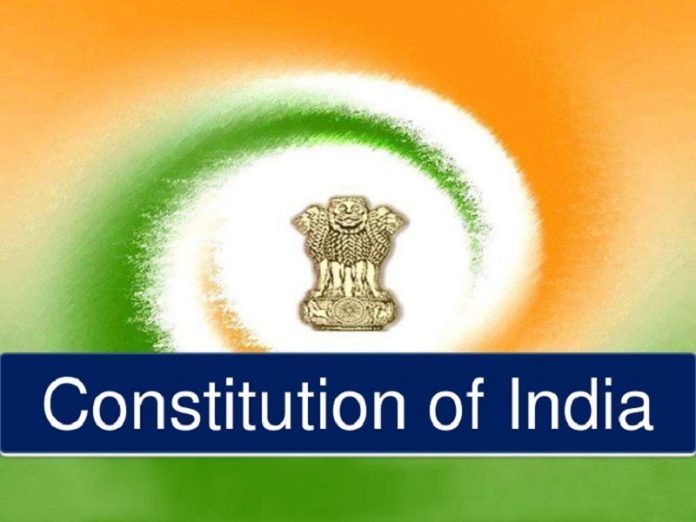The constitution of India has several salient features that distinguish it from the constitutions of other countries.
It should be noted at the outset that a number of original features of the Constitution (as adopted in 1949) have undergone a substantial change, on account of several amendments, particularly 7th, 42nd,44th, 73rd & other amendments.
Also, the 42nd Amendment Act (1976) is known as ‘Mini-Constitution’ due to the important and large number of changes made by it in various parts of the
Constitution.
SALIENT FEATURES OF THE CONSTITUTION:
Lengthiest Written Constitution
Constitutions are classified into written, like the American Constitution, or unwritten, like the British Constitution. The Constitution of India is the lengthiest of all the written constitutions of the world. It is a very comprehensive, elaborate and detailed document.
Originally (1949), the Constitution contained a Preamble, 395 Articles (divided into 22 Parts) and 8 Schedules. Presently, it consists of a Preamble, More than 450 Articles (divided into 22 Parts) and 12 Schedules.
Drawn From Various Sources
The Constitution of India has borrowed most of its provisions from the constitutions of various other countries as well as from the Government of India Act of 1935. Dr B R Ambedkar proudly acclaimed that the Constitution of India has been framed after‘ransacking all the known Constitutions of the World’.
The structural part of the Constitution is, to a large extent, derived from theGovernment of India Act of 1935. The philosophical part of the Constitution (the Fundamental Rights and the Directive Principles of State Policy) derive their inspiration from the American and Irish Constitutions respectively.
The other provisions of the Constitution have been drawn from the constitutions of Canada, Australia, Germany, USSR (now Russia), France, South Africa, Japan, and so on
Blend of Rigidity and Flexibility
Constitutions are also classified into rigid and flexible. A rigid Constitution is one that requires a special procedure for its amendment, as for example, the American Constitution. A flexible constitution, on the other hand, is one that can be amended in the same manner as the ordinary laws are made, as for example, the British Constitution.
The Constitution of India is neither rigid nor flexible but a synthesis of both. Article 368 provides for two types of amendments:
(a) Some provisions can be amended by a special majority of the Parliament.
(b) Some other provisions can be amended by a special majority of the Parliament and with the ratification by half of the total states.
(c) Some provisions of the Constitution can be amended by a simple majority of the Parliament in the manner of ordinary legislative process. Notably, these amendments do not come under Article 368.
Federal System with Unitary Bias
The Constitution of India establishes a federal system of government. It contains all the usual features of a federation, viz., two government, division of powers, written Constitution, supremacy of Constitution, rigidity of Constitution, independent judiciary and bicameralism.
However, the Indian Constitution also contains a large number of unitary or non-federal features, viz., a strong Centre, single Constitution, single citizenship, flexibility of Constitution, integrated judiciary, appointment of state governor by the Centre, all-India services, emergency provisions, and so on.
Parliamentary Form of Government
The Constitution of India has opted for the British parliamentary System of Government rather than American Presidential System of Government. The parliamentary system is based on the principle of cooperation and co-ordination between the legislative and executive organs while the presidential system is based on the doctrine of separation of powers between the two organs.
Integrated and Independent Judiciary
The Indian Constitution establishes a judicial system that is integrated as well as independent. The Supreme Court stands at the top of the integrated judicial system in the country. Below it, there are high courts at the state level. Under a high court, there is a hierarchy of subordinate courts, that is, district courts and other lower courts. This single system of courts enforces both the central laws as well as the state laws, unlike in USA, where the federal laws are enforced by the federal judiciary and the state laws are enforced by the state judiciary.
A Secular State
The Constitution of India stands for a secular state. Hence, it does not uphold any particular religion as the official religion of the Indian State. These are some of the following provisions of the Constitution reveal the secular character of the Indian State:
(a) The term ‘secular’ was added to the Preamble of the Indian Constitution by the 42nd Constitutional Amendment Act of 1976.
(b) The Preamble secures to all citizens of India liberty of belief, faith and worship.
(c) The State shall not deny to any person equality before the law or equal protection of the laws (Article 14).
(d) The State shall not discriminate against any citizen on the ground of religion(Article 15).
(e) Equality of opportunity for all citizens in matters of public employment (Article 16).
Universal Adult Franchise
The Indian Constitution adopts universal adult franchise as a basis of elections to theLok Sabha and the state legislative assemblies. Every citizen who is not less than 18 years of age has a right to vote without any discrimination of caste, race, religion, sex, literacy, wealth, and so on. The voting age was reduced to 18 years from 21 years in 1989 by the 61st Constitutional Amendment Act of 1988.
Single Citizenship
Though the Indian Constitution is federal and envisages a dual polity (Centre and states), it provides for only a single citizenship, that is, the Indian citizenship.
Independent Bodies
The Indian Constitution also establishes certain independent bodies.Some of them are:
(a) Election Commission
(b) Comptroller and Auditor-General of India
(c) Union Public Service Commission
(d) State Public Service Commission





















